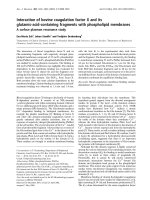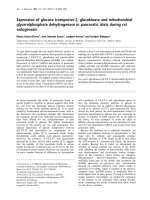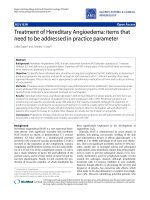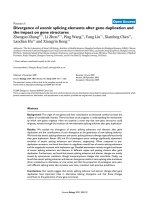Báo cáo y học: "Changes of uterine blood flow after vaginal radical trachelectomy (VRT) in patients with early-stage uterine invasive cervical cancer"
Bạn đang xem bản rút gọn của tài liệu. Xem và tải ngay bản đầy đủ của tài liệu tại đây (859.22 KB, 7 trang )
Int. J. Med. Sci. 2010, 7
260
I
I
n
n
t
t
e
e
r
r
n
n
a
a
t
t
i
i
o
o
n
n
a
a
l
l
J
J
o
o
u
u
r
r
n
n
a
a
l
l
o
o
f
f
M
M
e
e
d
d
i
i
c
c
a
a
l
l
S
S
c
c
i
i
e
e
n
n
c
c
e
e
s
s
2010; 7(5):260-266
© Ivyspring International Publisher. All rights reserved
Research Paper
Changes of uterine blood flow after vaginal radical trachelectomy (VRT) in
patients with early-stage uterine invasive cervical cancer
Kota Umemura
1
, Shin-ichi Ishioka
1
, Toshiaki Endo
1
, Tsuyoshi Baba
1
, Yoshiaki Ezaka
1
, Kunihiko Naga-
sawa
1
,
Madoka Takahashi
1
, Masahito Mizuuchi
1
, Nanako Iwami
1
, Hidefumi Adachi
1
, Noriko Takeda
1
, Mit-
suharu Tamagawa
2
, Tsuyoshi Saito
1
1. Department of Obstetrics and Gynecology, Sapporo Medical University, Sapporo Hokkaido, Japan
2. Department of Radiology, Sapporo Medical University, Sapporo Hokkaido, Japan
Corresponding author: Shin-ichi Ishioka, Department of Obstetrics and Gynecology, Sapporo Medical University. Mi-
nami 1-jo, Nishi 16-chome, Chuo-ku, Sapporo Hokkaido, Japan 064-8543. Tel. +81-11-611-2111 (ext. 3373); Fax
+81-11-563-0860; e-mail:
Received: 2010.06.02; Accepted: 2010.08.04; Published: 2010.08.05
Abstract
Background. Vaginal radical trachectomy (RT) ligates and cuts several arteries supplying the
uterus. Changes of blood supply to the uterus in two patients who experienced pregnancy and
delivery were studied by using 3-D CT scanning. Effects of changes of blood supply to the
uterus on the pregnancy courses were also examined.
Methods. Vascular distribution in the uterus was studied in two patients who received vaginal
RT after delivery. Effects of changes of vascular distribution after vaginal RT were studied with
respect to pregnancy courses and cervical functions.
Results. New arterial vascularization from the ascending branches of uterine arteries or other
arteries occurred, and these new vessels seemed to supply blood to the remaining cervix.
Differences of fetal growth and histopathological changes in the placenta between the two
patients could not be detected.
Conclusion. Ligation and cutting of several supplying arteries by RT induces new areterial
vascularization and it does not seem to affect fetal growth and placental function.
Key words: Radical trachelectomy, uterine cervical cancer, 3-D CT scanning
Introduction
Uterine cervical cancer is one of the most com-
mon cancers diagnosed in women of reproductive
age. Thanks to the progress of the cervical cancer
screening system, the mortality rate of patients with
cervical cancer has decreased in Japan over the past
twenty years
1
. However, the number of patients with
early invasive cervical cancer during reproductive age
is increasing. Not a few of them hope to preserve their
fertility. Recently, radical trachelectomy (RT) with
pelvic lymphadenctomy has become a valuable fertil-
ity-preserving treatment option for these patients in
Japan
2-4
. We have already performed 20 vaginal RTs
with laparoscopic lymphadenectomy, and have expe-
rienced five pregnancies and four deliveries so far. As
we reported before, in pregnant patients who under-
go this operation, premature labor and the following
occurrence of preterm premature rupture of the
membrane (pPROM) are thought to be the most
troublesome pregnancy-related complications
3
. Var-
ious factors such as lack of a protective effect against
vaginal infection or the lack of mechanical support of
the residual cervix due to the dissection of the uterine
cervix and the division of supplying arteries might
induce such complications. On the basis of these
Int. J. Med. Sci. 2010, 7
261
complications, there might be reduced blood supply
to the remaining uterus. Furthermore, if the blood
supply to the uterus is reduced, it could be a cause of
intrauterine growth retardation (IUGR) or intraute-
rine fetal death (IUFD)
5
.
In this report, we studied changes of the blood
supply to the uterus in two patients who experienced
pregnancy and delivery. Effects of these changes on
the pregnancy courses are also discussed.
Patients and methods
In the period from January 2003 through De-
cember 2009, a total of 20 women with early-stage
invasive uterine cancer underwent vaginal RT with
lymphadenectomy in Sapporo Medical University
Hospital. Among them, five patients became preg-
nant, and four of them delivered by cesarean section.
In this study, we performed 3-D CT scanning for as-
sessment of the blood supply to the uterus in two pa-
tients who had undergone vaginal RT with pelvic
lymphadenectomy after delivery. 3-D CT scanning
was also performed in a woman with normal uterus
after the delivery for the assessment of an in-
tra-abdominal disease, and her picture was used as a
control. The clinical courses of pregnancy, fetal
growth measured by ultrasonography, and results of
histopathological examination of the placenta were
also compared between the two patients. Characteris-
tics of both patients are presented in Table 1. Patient 1
was a 35-year-old Japanese woman, gravida 0 para 0.
As a pap smear at a local clinic showed atypical
squamous cells corresponding to cervical intraepi-
thelial neoplasia (CIN) 3, she was referred to our
hospital. She received diagnostic laser conization, and
she was diagnosed as having stage Ib1 squamous cell
carcinoma. Then she underwent vaginal RT and la-
paroscopic lymphadenectomy, and she became
pregnant six months after the operation by artificial
intrauterine insemination. She was admitted to our
hospital with a diagnosis of threatened abortion at 17
weeks of gestation. In spite of bed rest, disinfection
therapy, and the administration of ritodrine, she suf-
fered from pPROM at 23 weeks of gestation. There-
fore she underwent emergent cesarean section at 24
weeks of gestation.
Patient 2 was a 28-year-old Japanese woman,
gravida 0 para 0. She was diagnosed as having stage
Ib1 cervical squamous cell carcinoma by diagnostic
laser conization at a local hospital. She was referred to
our hospital for fertility-sparing treatment. She also
underwent vaginal RT and laparoscopic lymphade-
nectomy. At 14 months after the operation, she be-
came pregnant without any artificial reproductive
techniques. We recommended her to enter our hos-
pital early in the second trimester in spite of no signs
of threatened abortion. Daily vaginal disinfection
with popidone iodine, bed rest, and administration of
ritodrine and an ulinastatin vaginal suppository were
continued as a new follow-up modality for pregnant
patients who received RT. Finally, at 35 weeks of
gestation, scheduled cesarean section was performed
for her.
The postpartum courses of the patients were not
remarkable, and no signs of recurrence have been
seen for either patient up to now. Their menstrual
cycles also restarted within 6 months postpartum.
Vaginal RT was performed using the laparosco-
pico-vaginal procedure of Dargent et al. Briefly, a rim
of vaginal mucosa was delineated circumferentially
and excised so that the anterior and posterior muco-
sae could cover the cervix. The vesicovaginal space
was defined laterally on each side. After identification
of the ureters, the bladder pillars were separated and
sectioned. Then the proximal parametrium and the
cervicovaginal branches of the uterine arteries were
excised. After these procedures, the cervix was am-
putated approximately 10 mm below the isthmus, a
nylon suture was placed around the cervix, and a
Sturumdorf suture was placed to cover the surface of
the cervix.
Table 1. Clinical characteristics of patients.
Patient 1 Patient 2
age(years) and parity 35
P0(0)
28
P0(0)
histology and clinical stage SCC stage Ib1 SCC stage Ib1
gestation at delivery 24 weeks + 1 day 34 weeks + 6 day
birth weight and Apgar
score
588g
1
(1min.)/1(5min.)
1862g
7(1min.)/8(5min.)
pathology of placenta Ischemic change(-)
CAM
(+)
Ischemic change(-)
CAM(-)
prognosis NED 27 months NED 54months
P(0) means pregnancy0 and delivery0. SCC means squamous cell
carcinoma.
CAM means chorioamnionitis. NED means “no evidence of dis-
ease”.
Results
Figures 1 and 2 show the blood vessel distribu-
tion in the uterus for both patients. Figure 3 shows the
blood distribution in the normal uterus after the de-
livery. Identification of blood vessels was performed
by a radiologist (M.T).
Int. J. Med. Sci. 2010, 7
262
Fig. 1 3-D computed tomography (CT) imaging of patient 1. a: Left uterine artery. No descending branch was seen. b: New
vessels probably arisen from ascending branch of left uterine artery. c: New vessels probably arisen from ascending branch
of right uterine artery. d: Right uterine artery. No descending branch was seen. Identification of each vessel was made by a
radiologist (M.T).
Fig. 2 3-D CT imaging of patient 2. e: Left uterine artery. No descending branch was seen. f: New vessels probably arisen
from ascending branch of left uterine artery and some arteries from vagina or pelvic wall . g: New vessels probably arisen
from some arteries from vagina or pelvic wall. h: Right ovarian artery supplying blood to the remaining uterus. No right
uterine artery could be detected. Main blood supply of the right side of the uterus was through “g” and “h”. Identification of
each vessel was also made by a radiologist (M.T).
Int. J. Med. Sci. 2010, 7
263
In vaginal RT, we usually amputate the cervix at
the level of the uterine artery, which corresponds to
approximately 10 mm below the isthmus. In this
procedure, we usually ligate and cut the descending
branches of the uterine arteries and vaginal arteries.
These arteries mainly supply blood to the lower seg-
ment of the uterus. Fig. 1 and Fig. 2 show that the
descending branches of uterine arteries and vaginal
arteries could not be seen in either patient. New ar-
terial vascularization from the ascending branches of
uterine arteries arose, and these new vessels seemed
to supply blood to the remaining cervix, including the
neo-cervix. On the 3-D CT scan, no ischemic areas
were seen in the remaining uterus.
Fig. 3 shows the fetal growth of both patients.
Patient 1 received emergent cesarean section at 24
weeks of gestation because of sudden premature
rupture of the membrane. Therefore the birth weight
of the child of patient 1 was 588g, though she survived
thanks to the efforts of neonatologists and co-workers.
Fetal growth up to the delivery was appropriate for
gestational age for patient 1. Fetal growth of patient 2
was also within the normal range over the pregnancy
period. Fig. 4 shows changes of cervical length as
measured by transvaginal ultrasonography in the
both patients. The remaining cervix of patient 1 was
shorter than that of patient 2 over the pregnancy pe-
riod.
Furthermore as shown in Table 1, the placenta
from patient 1 showed the existence of severe cho-
rioamionitis, which might have been a cause of
pPROM; however, no ischemic changes of the pla-
centa were detected histopathologically. The placenta
of patient 2, who delivered at 35 weeks of gestation,
did not show ischemic changes either.
Fig. 3 3-D CT imaging of a patient with normal uterus after the delivery. A: Ascending branch of right uterine artery. B:
Ascending branch of left uterine artery. C: Descending branch of right uterine artery. D: Descending branch of left uterine
artery. Identification of each vessel was also made by a radiologist (M.T).
Int. J. Med. Sci. 2010, 7
264
Fig. 4 Ultrasonographic changes of BPD as a marker of fetal growth in patient 1 and patient 2. Fetal growth of each patient
assessed by the changes of BPD (biparietal diameter) was within normal range over the pregnancy period, although patient
1 received emergent cesarean section at 24 weeks of gestation because of sudden premature rupture of the membrane.
Fig. 5 Transvaginal ultrasonographic changes of cervical length during pregnancy after vaginal radical trachelectomy(RT).
The remaining cervix of patient 1 was shorter than that of patient 2 over the pregnancy period.
Discussion
In this study, we looked at changes of blood
supply to the uterus after vaginal RT in two patients
who experienced pregnancy. The effects of blood
supply on the fetal growth and the placental changes
were also studied. RT removes the cervix of the ute-
rus, parametrium, and upper vagina through a va-
ginal approach and is designed to preserve child-
bearing potential in young patients with cervical
cancer. This procedure requires ligation and cutting
the descending branches of uterine arteries as well as
the division of vaginal arteries. The uterus has six
main supplying arteries: two ovarian, two uterine,
and two vaginal arteries. It is said that four of the six
arteries are required to ensure uterine viability
5
.
However, almost half of the supplying arteries are cut
after vaginal RT. Sieunarine et al. reported that the
blood flow reduction after ovarian artery ligation was









